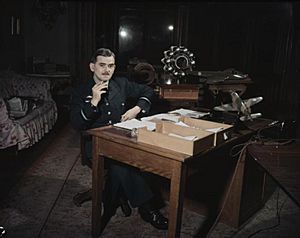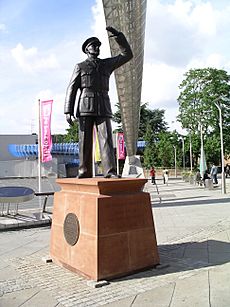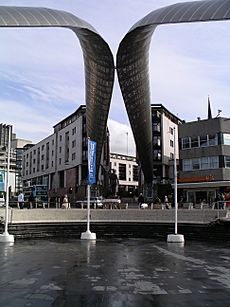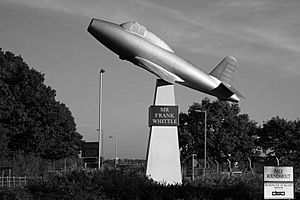Frank Whittle facts for kids
Quick facts for kids
Sir Frank Whittle
|
|
|---|---|
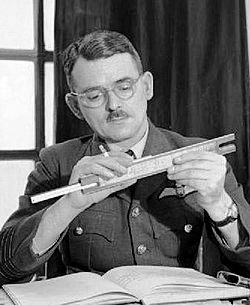 |
|
| Born | 1 June 1907 Earlsdon, Coventry, England |
| Died | 9 August 1996 (aged 89) Columbia, Maryland, United States |
| Buried |
Cranwell, England
|
| Allegiance | United Kingdom |
| Service/ |
Royal Air Force |
| Years of service | 1923–1948 |
| Rank | Air Commodore |
| Battles/wars | Second World War |
| Awards | Member of the Order of Merit Knight Commander of the Order of the British Empire Companion of the Order of the Bath Commander of the Legion of Merit (United States) Rumford Medal Louis E. Levy Medal Fellow of the Royal Society Honorary Fellow of the Royal Aeronautical Society Charles Stark Draper Prize Prince Philip Medal |
| Spouse(s) |
Dorothy Lee
(m. 1930; div. 1976)Hazel Hall
(m. 1976) |
| Other work | BOAC technical advisor, Shell engineer, engineer for Bristol Aero Engines, NAVAIR Professor at the US Naval Academy |
Air Commodore Sir Frank Whittle, OM, KBE, CB, FRS, FRAeS (1 June 1907 – 9 August 1996) was an English inventor and Royal Air Force air officer. He is credited with co-inventing the turbojet engine. A patent was submitted by Maxime Guillaume in 1921 for a similar invention; however, this was technically unfeasible at the time. Whittle's jet engines were developed some years earlier than those of Germany's Hans von Ohain who was the designer of the first operational turbojet engine.
From an early age, Whittle demonstrated an aptitude for engineering and an interest in flying. At first he was turned down by the RAF but, determined to join the Royal Air Force, he overcame his physical limitations and was accepted and sent to No. 2 School of Technical Training to join No 1 Squadron of Cranwell Aircraft Apprentices. He was taught the theory of aircraft engines and gained practical experience in the engineering workshops. His academic and practical abilities as an Aircraft Apprentice earned him a place on the officer training course at Cranwell. He excelled in his studies and became an accomplished pilot. While writing his thesis there he formulated the fundamental concepts that led to the creation of the turbojet engine, taking out a patent on his design in 1930. His performance on an officers' engineering course earned him a place on a further course at Peterhouse, Cambridge, where he graduated with a First.
Without Air Ministry support, he and two retired RAF servicemen formed Power Jets Ltd to build his engine with assistance from the firm of British Thomson-Houston. Despite limited funding, a prototype was created, which first ran in 1937. Official interest was forthcoming following this success, with contracts being placed to develop further engines, but the continuing stress seriously affected Whittle's health, eventually resulting in a nervous breakdown in 1940. In 1944 when Power Jets was nationalised he again suffered a nervous breakdown, and resigned from the board in 1946.
In 1948, Whittle retired from the RAF and received a knighthood. He joined BOAC as a technical advisor before working as an engineering specialist with Shell, followed by a position with Bristol Aero Engines. After emigrating to the U.S. in 1976 he accepted the position of NAVAIR Research Professor at the United States Naval Academy from 1977 to 1979. In August 1996, Whittle died of lung cancer at his home in Columbia, Maryland. In 2002, Whittle was ranked number 42 in the BBC poll of the 100 Greatest Britons.
Contents
Early life
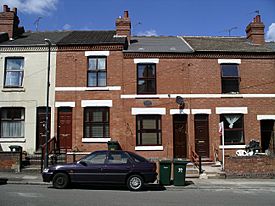
Whittle was born in a terraced house in Newcombe Road, Earlsdon, Coventry, England on 1 June 1907, the eldest son of Moses Whittle and Sara Alice Garlick. When he was nine years old, the family moved to the nearby town of Royal Leamington Spa where his father, a highly inventive practical engineer and mechanic, purchased the Leamington Valve and Piston Ring Company, which comprised a few lathes and other tools and a single-cylinder gas engine, on which Whittle became an expert. Whittle developed a rebellious and adventurous streak, together with an early interest in aviation.
After two years attending Milverton School, Whittle won a scholarship to a secondary school which in due course became Leamington College for Boys, but when his father's business faltered there was not enough money to keep him there. He quickly developed practical engineering skills while helping in his father's workshop, and being an enthusiastic reader spent much of his spare time in the Leamington reference library, reading about astronomy, engineering, turbines, and the theory of flight. At the age of 15, determined to be a pilot, Whittle applied to join the RAF.
Entering the RAF
In January 1923, having passed the RAF entrance examination with a high mark, Whittle reported to RAF Halton as an Aircraft Apprentice. He lasted only two days: just five feet tall and with a small chest measurement, he failed the medical. He then put himself through a vigorous training programme and special diet devised by a physical training instructor at Halton to build up his physique, only to fail again six months later, when he was told that he could not be given a second chance, despite having added three inches to his height and chest. Undeterred, he applied again under an assumed name and presented himself as a candidate at the No 2 School of Technical Training RAF Cranwell. This time he passed the physical and, in September that year, 364365 Boy Whittle, F started his three-year training as an aircraft mechanic in No. 1 Squadron of No. 4 Apprentices Wing, RAF Cranwell, because RAF Halton No. 1 School of Technical Training was unable to accommodate all the aircraft apprentices at that time.
Whittle hated the strict discipline imposed on apprentices and, convinced there was no hope of ever becoming a pilot, he at one time seriously considered deserting. However, throughout his early days as an aircraft apprentice (and at the Royal Air Force College Cranwell), he maintained his interest in model aircraft and joined the Model Aircraft Society, where he built working replicas. The quality of these attracted the eye of the Apprentice Wing commanding officer, who noted that Whittle was also a mathematical genius. He was so impressed that in 1926 he recommended Whittle for officer training at RAF College Cranwell.
For Whittle, this was the chance of a lifetime, not only to enter the commissioned ranks but also because the training included flying lessons on the Avro 504. While at Cranwell he lodged in a bungalow at Dorrington. Being an ex-apprentice amongst a majority of ex-public schoolboys, life as an officer cadet was not easy for him, but he nevertheless excelled in the courses and went solo in 1927 after only 13.5 hours instruction, quickly progressing to the Bristol Fighter and gaining a reputation for daredevil low flying and aerobatics.
A requirement of the course was that each student had to produce a thesis for graduation: Whittle decided to write his on potential aircraft design developments, notably flight at high altitudes and speeds over 500 mph (800 km/h). In Future Developments in Aircraft Design he showed that incremental improvements in existing propeller engines were unlikely to make such flight routine. Instead he described what is today referred to as a motorjet; a motor using a conventional piston engine to provide compressed air to a combustion chamber whose exhaust was used directly for thrust – essentially an afterburner attached to a propeller engine. The idea was not new and had been talked about for some time in the industry, but Whittle's aim was to demonstrate that at increased altitudes the lower outside air pressure would increase the design's efficiency. For long-range flight, using an Atlantic-crossing mailplane as his example, the engine would spend most of its time at high altitude and thus could outperform a conventional powerplant.
Of the few apprentices accepted into the Royal Air Force College, Whittle graduated in 1928 at the age of 21 and was commissioned as a pilot officer in July. He ranked second in his class in academics, won the Andy Fellowes Memorial Prize for Aeronautical Sciences for his thesis, and was described as an "exceptional to above average" pilot. However, his flight logbook also showed numerous red ink warnings about showboating and overconfidence, and because of dangerous flying in an Armstrong Whitworth Siskin he was disqualified from the end of term flying contest.
After the war

In 1946 Whittle accepted a post as Technical Advisor on Engine Design and Production to Controller of Supplies (Air); was made a Commander of the US Legion of Merit; and was appointed a Companion of the Order of the Bath in 1947. During May 1948 Whittle received an ex-gratia award of £100,000 from the Royal Commission on Awards to Inventors in recognition of his work on the jet engine, and two months later he was made a Knight Commander of the Order of the British Empire.
During a lecture tour in the US, Whittle again broke down and retired from the RAF on medical grounds on 26 August 1948, leaving with the rank of air commodore. He joined BOAC as a technical advisor on aircraft gas turbines and travelled extensively over the next few years, viewing jet engine developments in the United States, Canada, Africa, Asia and the Middle East. He left BOAC in 1952 and spent the next year working on a biography, Jet: The Story of a Pioneer. He was awarded the Royal Society of Arts' Albert Medal that year.
Returning to work in 1953, he accepted a position as a Mechanical Engineering Specialist with Shell, where he developed a new type of self-powered drill driven by a turbine running on the lubricating mud that is pumped into the borehole during drilling. Normally a well is drilled by attaching rigid sections of pipe together and powering the cutting head by spinning the pipe from the surface, but Whittle's design removed the need for a strong mechanical connection between the drill and the head frame, allowing for much lighter piping to be used. He gave the Royal Institution Christmas Lectures in 1954 on The Story of Petroleum.
Turbine drilling is best used for drilling hard rocks at high bit RPMs with diamond impregnated bits, and can be used with an angled drive shaft for directional drilling and horizontal drilling. It competes though with moyno motors and increasingly with rotary steerable systems and is again out of favour.
Whittle left Shell in 1957 to work for Bristol Aero Engines who picked up the project in 1961, setting up "Bristol Siddeley Whittle Tools" to further develop the concept. In 1966 Rolls-Royce purchased Bristol Siddeley, but the financial pressures and eventual bankruptcy because of cost overruns of the RB211 project led to the slow wind-down and eventual disappearance of Whittle's "turbo-drill". The concept eventually re-appeared in the west in the late 1980s, imported from Russian designs. (Russia needed the technology because it lacked high strength drill pipe.)
As part of his socialist ideals, he proposed that Power Jets be nationalised; in part because he saw that private companies would profit from the technology freely given during the war. By 1964 he had deserted his previously socialist beliefs, going so far as to launch a fierce attack on the Labour candidate in Smethwick.
In 1960 he was awarded an honorary degree, doctor techn. honoris causa, at the Norwegian Institute of Technology, later part of Norwegian University of Science and Technology.
In 1967, he was awarded an Honorary Degree (Doctor of Science) by the University of Bath. That year, he was inducted into the International Air & Space Hall of Fame.
In 1987, he was awarded an Honorary Degree (Doctor of Technology) by Loughborough University.
Later life
Whittle received the Tony Jannus Award in 1969 for his distinguished contributions to commercial aviation.
In 1976, his marriage to Dorothy was dissolved and he married American Hazel S. Hall ("Tommie"). He emigrated to the US and the following year accepted the position of NAVAIR Research Professor at the United States Naval Academy (Annapolis, Maryland). His research concentrated on the boundary layer before his professorship became part-time from 1978 to 1979. The part-time post enabled him to write a textbook entitled Gas turbine aero-thermodynamics: with special reference to aircraft propulsion, published in 1981.
Having first met Hans von Ohain in 1966, Whittle again met him at Wright-Patterson Air Force Base in 1978 while von Ohain was working there as the Aero Propulsion Laboratory's Chief Scientist. Initially upset because he had believed von Ohain's engine had been developed after seeing Whittle's patent, he eventually became convinced that von Ohain's work was, in fact, independent. The two became good friends and often toured the US giving talks together.
In a conversation with Whittle after the war, von Ohain stated: "If you had been given the money you would have been six years ahead of us. If Hitler or Goering had heard that there is a man in England who flies 500 mph in a small experimental plane and that it is coming into development, it is likely that World War II would not have come into being."
In 1986, Whittle was appointed a member of the Order of Merit (Commonwealth). He was made a Fellow of the Royal Society, and of the Royal Aeronautical Society, and in 1991 he and von Ohain were awarded the Charles Stark Draper Prize for their work on turbojet engines.
Whittle became an atheist by degrees.
Whittle died of lung cancer on 9 August 1996, at his home in Columbia, Maryland. He was cremated in America and his ashes were flown to England where they were placed in a memorial in a church in Cranwell. Lady Hazel Whittle died on 30 July 2007 aged 91.
Styles and promotions
- 1907–1923: Frank Whittle
- 1923–1926: Apprentice Frank Whittle
- 1926–1928: Officer Cadet Frank Whittle
- 1928–1930: Pilot Officer Frank Whittle
- 1930–1934: Flying Officer Frank Whittle
- 1934–1938: Flight Lieutenant Frank Whittle
- 1938–1940: Squadron Leader Frank Whittle
- 1940–1941: Squadron Leader (Temp. Wing Commander) Frank Whittle
- 1941–1943: Wing Commander Frank Whittle
- 1943–1944: Wing Commander (Temp. Group Captain) Frank Whittle
- 1944–1946: Group Captain (Actg. Air Commodore) Frank Whittle, CBE
- 1946–1947: Group Captain (Temp. Air Commodore) Frank Whittle, CBE
- 1947–1948: Group Captain (Temp. Air Commodore) Frank Whittle, CB, CBE
- 1948–1986: Air Commodore Sir Frank Whittle, KBE, CB
- 1986–1996: Air Commodore Sir Frank Whittle, OM, KBE, CB, FRS, FRAeS
Memorials
Coventry, England
- The "Whittle Arch" is a large double wing-like structure situated outside the Coventry Transport Museum, Millennium Place, Coventry City Centre.
- A statue of Whittle by Faith Winter is situated under the Whittle Arch. It was unveiled on 1 June 2007 by his son, Ian Whittle, during a televised event. It shows Whittle at RAF Cranwell looking towards the sky observing the first test flight of a Whittle-powered Gloster E.28/39 on 15 May 1941.
- A school is named after Whittle in the Walsgrave suburb of Coventry. It was first called Frank Whittle Primary, then renamed in 1997 as Sir Frank Whittle Primary School. A jet engine replica sits in the reception area of the school, donated by Whittle himself during his life.
- A commemorative plaque marks the house in Newcombe Road, Earlsdon, Coventry, in which he was born and lived until age nine.
- On Hearsall Common, near Whittle's Coventry birthplace, a plaque commemorates where Whittle gained inspiration when he saw an aircraft land. It says "on this common Frank Whittle, jet pioneer, first felt the power of flight."
- Coventry University named a building after him.
- The main hangar at the Midland Air Museum is called The Sir Frank Whittle Jet Heritage Centre.
- Whittle house was one of the four "houses" at Finham Park School until they were renamed in 2008.
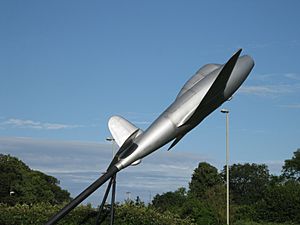
Lutterworth, England
- The Sir Frank Whittle Studio School is a studio school that opened in 2015. It is situated alongside Lutterworth College, both of which make up The Lutterworth Academies Trust.
- Lutterworth Museum hold a very large unrivalled collection of original papers including the 1936 Patent, Power Jets Autograph book from 1945 and the Champagne bottle signed by everyone at a party at RAF Cranwell on the night of the first flight plus many more artefacts and displays. Also Lutterworth Museum gives talks and put on displays all over the country.
- A memorial has been erected in the middle of a roundabout outside Lutterworth and a bust of Frank Whittle has been erected in Lutterworth, where much of Whittle's development on the jet engine was carried out.
- There is a bust of Sir Frank Whittle near the war memorial on the corner of Church and George street.
- The Sir Frank Whittle Public House was opened in 2010 and situated on the Greenacres estate in Lutterworth. It was replaced with a Co-operative convenience store much to the dismay of the residents.
- Whittle Road in Lutterworth was named after Sir Frank Whittle.
Rugby, England
- In Rugby where Whittle produced his first prototype engines, a bronze sculpture named Frank Whittle - Father of the Jet Engine was installed at Chestnut Field near Rugby Town Hall in 2005. It was made by the sculptor Stephen Broadbent, and represents a propeller transformed into an internal turbine of a jet engine.
Elsewhere
- In 2015, Whittle's college at the University of Cambridge, Peterhouse, opened the Whittle Building on its grounds.
- The Department of Engineering, University of Cambridge has a Whittle Laboratory.
- A full-scale model of the Gloster E28/39 Whittle has been erected just outside the northern boundary of Farnborough Airfield in Hampshire, UK.
- The Sir Frank Whittle Medal is awarded annually by the Royal Academy of Engineering to an engineer, normally resident in the UK, for outstanding and sustained achievement which has contributed to the well-being of the nation.
- Two roads in Derby are named Sir Frank Whittle Road and Sir Frank Whittle Way, as a tribute to his work at Rolls-Royce.
- The main office complex at the Rolls-Royce Bristol site has been named Whittle House.
- Whittle Parkway in Burnham is named after him.
- One of the main buildings at the Royal Air Force College Cranwell is called Whittle Hall. It houses the Officer & Aircrew Cadet Training Unit and the Air Power Studies Division of King's College London.
- A road in Cranford, on the site of the former Heston Aerodrome, is named Whittle Road.
- A road in Shaw, Oldham, is named Whittle Drive.
- A road in Rugby is named Whittle Close.
- Whittle Close in Clitheroe is named after him.
- Sir Frank Whittle Way, a new road in Blackpool Business park, Blackpool..
- The Whittle Gas field in the Southern North Sea operated by BP.
- The Whittle Inn near the Gloster Aircraft Company's former test runway in Hucclecote, Gloucestershire is named after Whittle; the nearby Tesco has a picture of a Gloster Meteor incorporated in part of its glass frontage.
- The bar/restaurant in Royal Mail's management college at Coton House, near Rugby, was named the Whittle Bar.
- A memorial stone was placed in the Royal Air Force Chapel in Westminster Abbey in his memory. The inscription on the stone reads: "Frank Whittle. Inventor & Pioneer of the Jet Engine. 1907–1996". The stone was carved by John Shaw (stone carver).
- Sir Frank Whittle's national and international honours, medals, and awards (including the Order of Merit), are displayed in the Royal Academy of Engineering, London.
- The Frank Whittle house, with its own building existed at the now closed Fairham Comprehensive School Clifton, Nottingham.
- A building at Aero Engine Controls in Birmingham, UK has been named 'The Whittle Building' (1994)
- Whittle Hangar is one of the main Hangars at HMS Sultan, and is used to house Royal Navy marine gas turbines. The gas turbines are fully operational and used to train Royal Navy and foreign officers and sailors in gas turbine technology.
- A plaque has been placed at the Port of Felixstowe to honour his link with the town (August 2010)
- A plaque commemorating Whittle has been placed inside the hall of Binswood Sixth Form College in Leamington Spa, formerly Leamington College for Boys.
- A plaque commemorating Whittle has been placed on Walland Hill, near Chagford in Devon, the house where he lived from 1962 to 1976
- One of the houses of Southam College is named after Whittle
- One of the houses of Milverton County Primary School is named after Whittle
Images for kids
See also
 In Spanish: Frank Whittle para niños
In Spanish: Frank Whittle para niños


